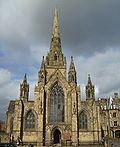| St Paul's Church, Peel | |
|---|---|
 The church from the north | |
 | |
| 53°31′51″N2°25′34″W / 53.5309°N 2.4260°W | |
| Location | Manchester Road, Little Hulton, Greater Manchester |
| Country | England |
| Denomination | Anglican |
| Website | |
| History | |
| Status | Parish church |
| Dedication | St Paul |
| Consecrated | December 1876 |
| Architecture | |
| Functional status | Active |
| Heritage designation | Grade II |
| Designated | 29 July 1966 |
| Architect(s) | J. Medland and Henry Taylor |
| Architectural type | Church |
| Style | Gothic Revival |
| Groundbreaking | 1874 |
| Completed | 1876 |
| Construction cost | Church c. £5,000 Spire £2,000 |
| Specifications | |
| Spire height | 165 feet (50 m) |
| Materials | Sandstone |
| Administration | |
| Province | York |
| Diocese | Manchester |
| Archdeaconry | Salford |
| Deanery | Eccles |
| Parish | Peel and Little Hulton |
St Paul's Church, Peel is an active Anglican parish church in Little Hulton, Greater Manchester, England. It is part of the Diocese of Manchester and is a Grade II listed building. [1] St Paul's serves the parish of Peel and Little Hulton and, together with St Paul's in Walkden and St John the Baptist in Little Hulton, is part of the Walkden and Little Hulton Team Ministry in the Eccles Deanery and Salford Archdeaconry. [2]




